Wooden staircases serve as both functional elements and stunning architectural features that can transform any home's interior. From upgrading the stair railing, to adding carpeting to the treads, to creating a gallery wall behind the staircase, there are different ways to elevate the look of wooden stairs. Whether you're planning a complete renovation or seeking subtle updates, wooden staircase designs offer endless possibilities to enhance your living space. These designs often feature sleek or complex geometries, and may include transparent elements like glass or acrylic, and dynamic forms that create visual intrigue. From rustic farmhouse charm to sleek contemporary elegance, wooden staircases can complement any architectural style while adding warmth and natural beauty to your home.
1. Floating Wooden Staircase with Steel Stringers
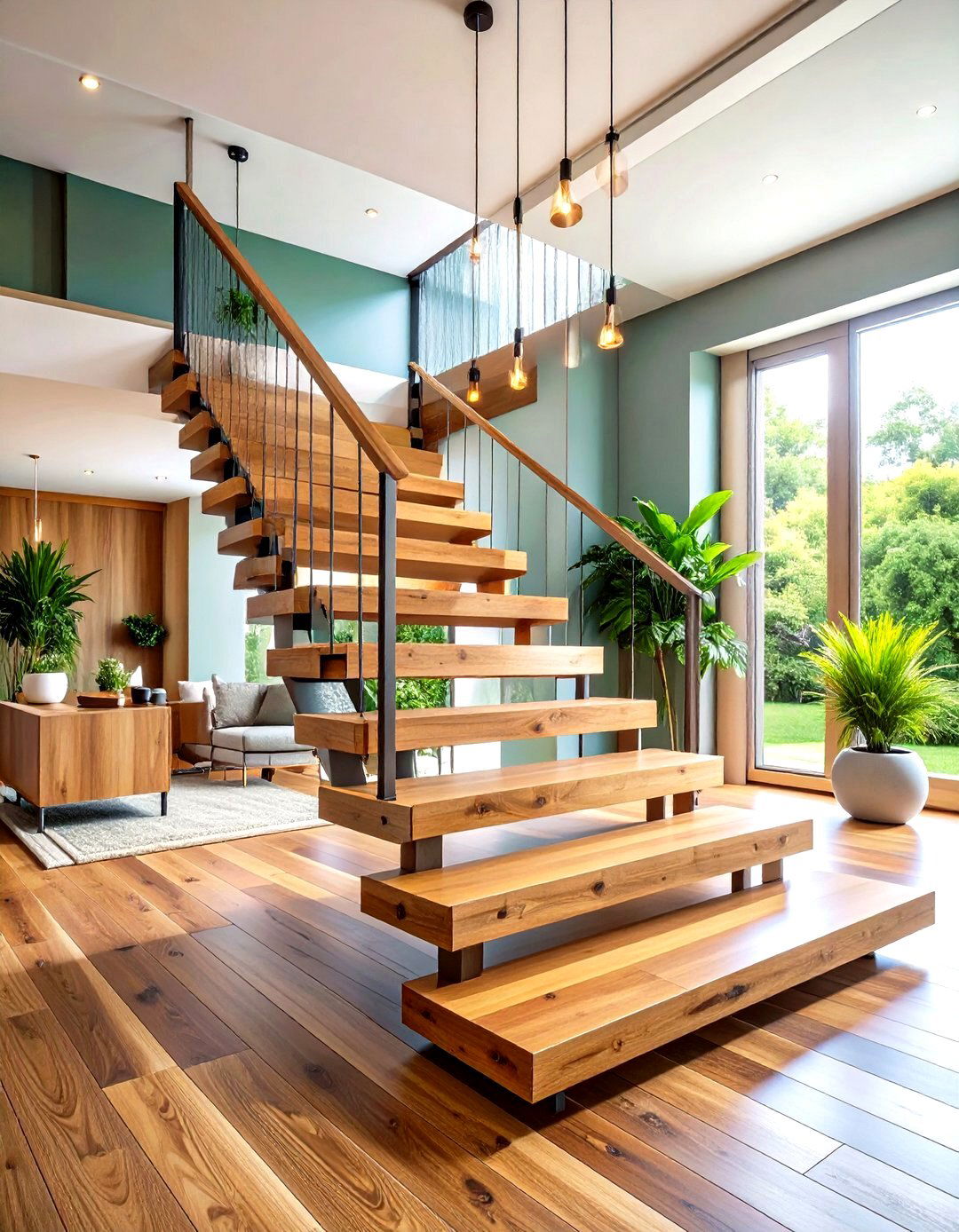
Floating wooden staircases create an illusion of weightlessness that captivates viewers instantly. Steel stringers, reclaimed oak treads, steel guardrails, painted trim, stained white pine timbers combine to form these architectural masterpieces. The treads appear to hover in mid-air, supported by hidden steel frameworks that provide structural integrity without compromising the minimalist aesthetic. While it is technically impossible to build entirely floating indoor staircases without structural support, meticulous planning and precision engineering enable us to craft staircases that appear to defy gravity. These designs work exceptionally well in modern homes where open floor plans and natural light flow are priorities. The wooden treads, typically crafted from oak, walnut, or maple, add warmth to the otherwise industrial support system, creating a perfect balance between contemporary sophistication and natural beauty.
2. Rustic Farmhouse Wooden Staircase with Shiplap Walls
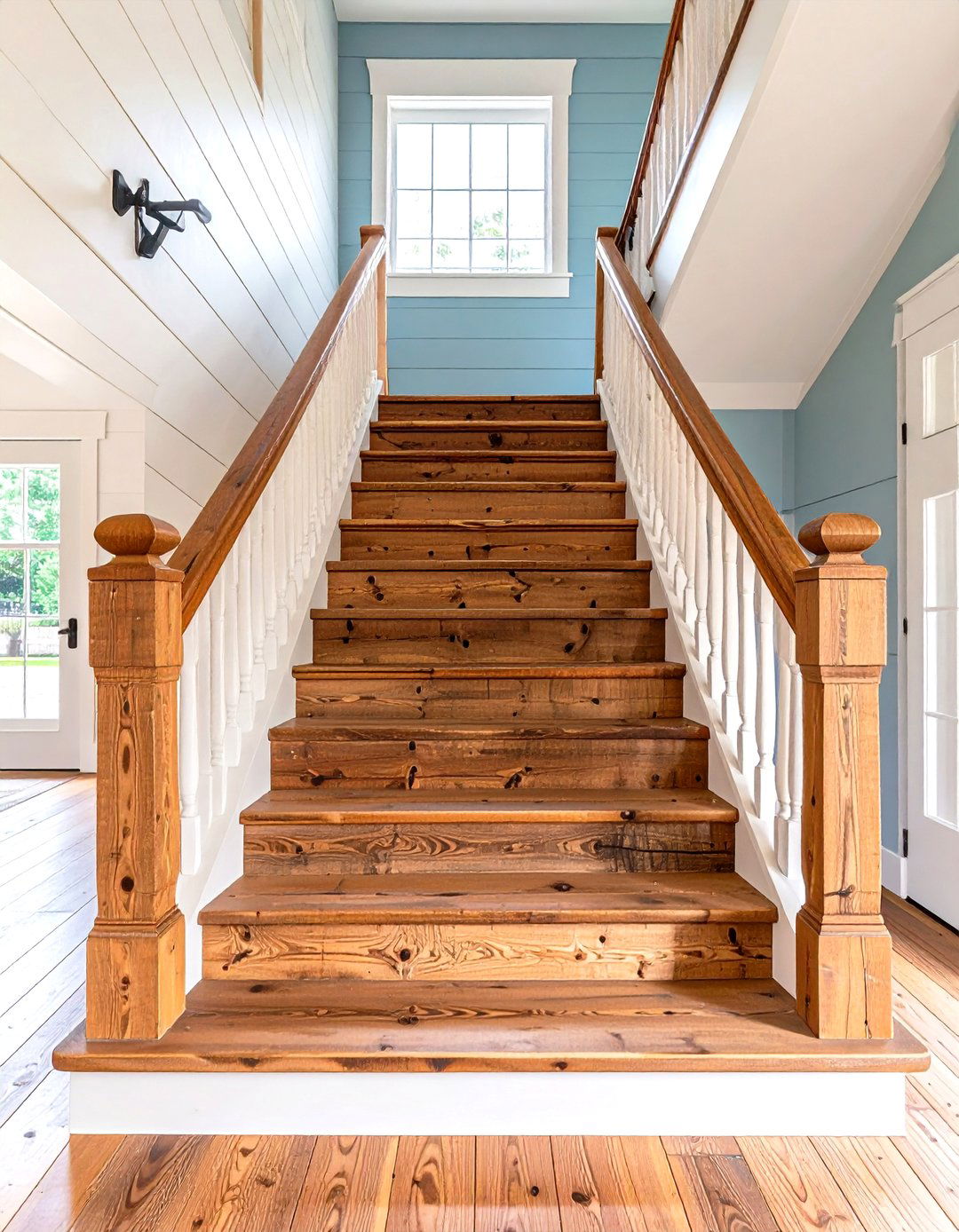
Transform your entrance with a rustic farmhouse wooden staircase featuring classic shiplap wall treatments. Another way to amplify the look of a wooden staircase and the surrounding area is to create a shiplap wall behind the stairs. Shiplap planks painted white add charm and a rustic-chic look to an otherwise ordinary space. This design combines natural wood treads with white-painted risers, creating visual depth and dimension. A simple white and wooden is perfect for the traditionalist, as this farmhouse look will never go out of style. The vertical shiplap installation makes ceilings appear taller while the wooden handrails, often stained in warm oak or weathered finishes, provide both safety and aesthetic appeal. Antique wood has a rich, dark patina that gives the wood staircase a naturally rustic appearance. Perfect for country cottages and modern farmhouse interiors.
3. Contemporary Wooden Staircase with Glass Panel Railings
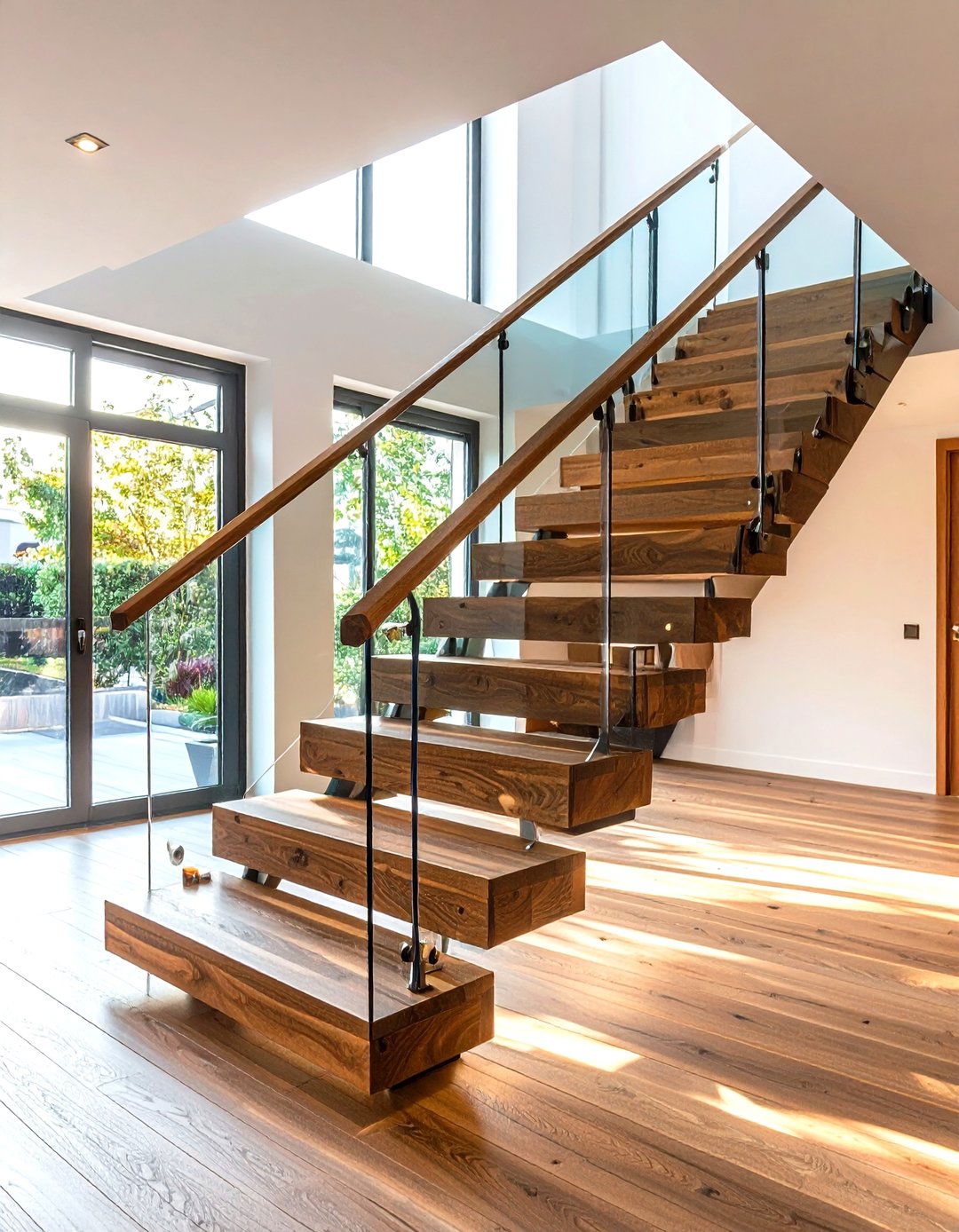
Contemporary wooden staircases paired with glass panel railings create sophisticated, light-filled spaces. The natural aesthetics of oak with glass balustrade offer a perfect blend of a contemporary and traditional vibe. These designs maximize natural light flow while maintaining clean, minimalist lines. The sleek, streamlined look of glass railing stairs perfectly complements contemporary, modern, and urban interior design aesthetics. The wooden treads, typically in rich walnut or blonde oak finishes, provide warmth against the cool transparency of glass panels. Wooden treads that appear as if they are floating look remarkably stunning with a glass railing. Steel or aluminum posts support the glass panels, creating structural integrity while maintaining visual lightness. This combination works beautifully in urban lofts, modern homes, and spaces where maintaining sight lines and light penetration are essential design goals.
4. Spiral Wooden Staircase with Curved Handrails

Spiral wooden staircases maximize space efficiency while creating dramatic focal points in any interior. A classic spiral staircase not only provides a visual point of interest—its narrow frame also fits within even the tightest of spaces. The curved wooden handrails follow the spiral's natural flow, typically crafted from laminated hardwoods that can bend gracefully without losing structural integrity. Solid Wood Spiral Stairs complement a traditional farmhouse interior with handcrafted pieces and over a dozen available wood species. These designs work exceptionally well in small homes, loft conversions, and as secondary staircases to upper levels. The wooden treads can be fashioned from various species including oak, cherry, or maple, each offering distinct grain patterns and color variations. The central support column, often made from steel but clad in matching wood, provides the necessary structural foundation while maintaining aesthetic continuity.
5. Industrial Wooden Staircase with Metal Cable Railings
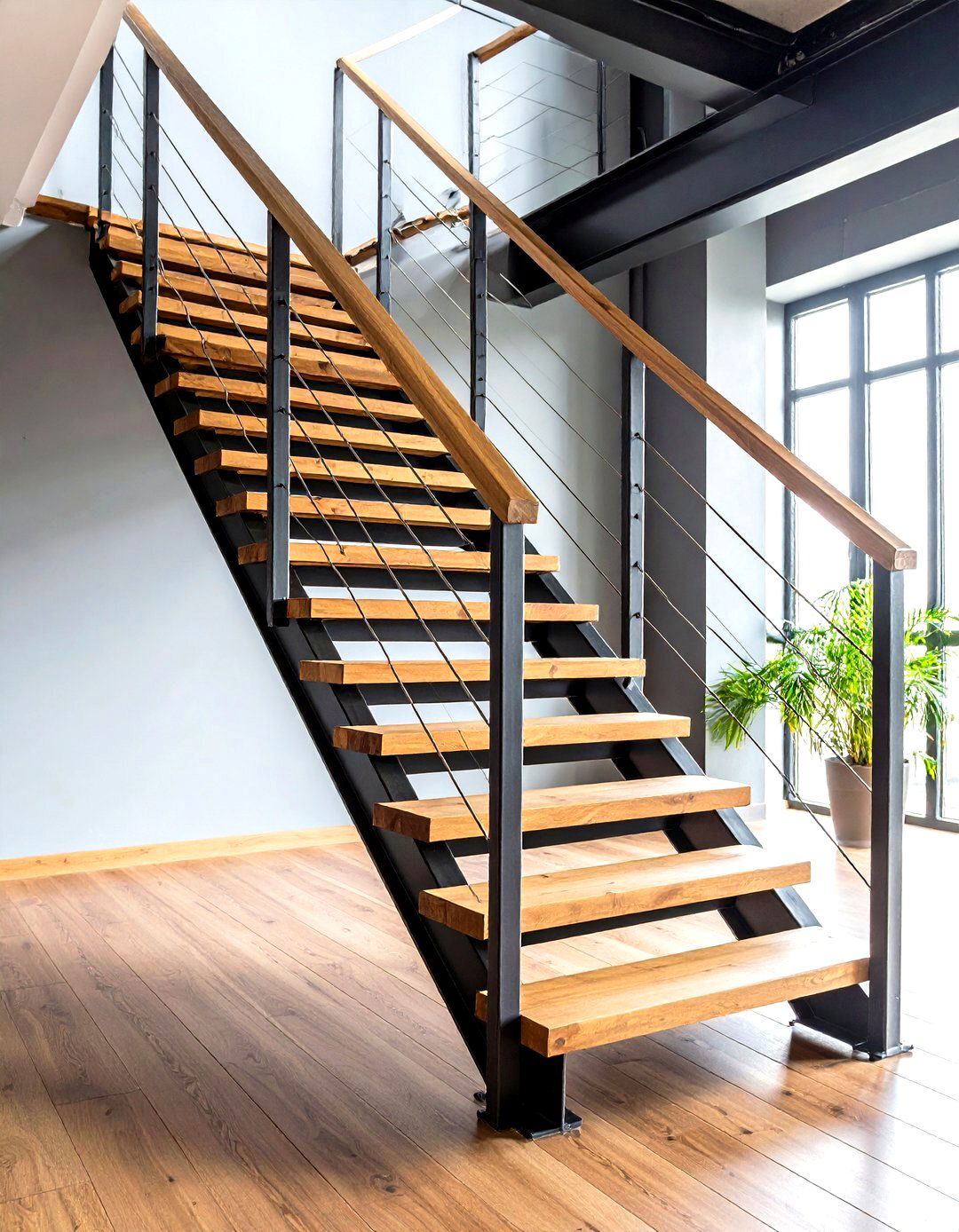
Industrial wooden staircases combine raw materials to create striking architectural statements. This staircase incorporates natural hardwood and metal accents to mimic the raw feel of a warehouse or factory. The sleek black outer stringers of the staircase and the metal cable railing, combined with the wooden treads and banister provide both form and function. The contrast between warm wood tones and cool metal elements creates visual tension that defines the industrial aesthetic. Cable railings offer unobstructed views while meeting safety requirements, their thin profiles maintaining the minimalist design philosophy. The I-beam steel stringers give the stairs a raw, manufactured appearance. These designs work particularly well in converted industrial spaces, modern lofts, and contemporary homes seeking an urban edge. The wooden elements soften the harsh industrial materials while maintaining the style's authentic character.
6. Reclaimed Wood Staircase with Natural Patina
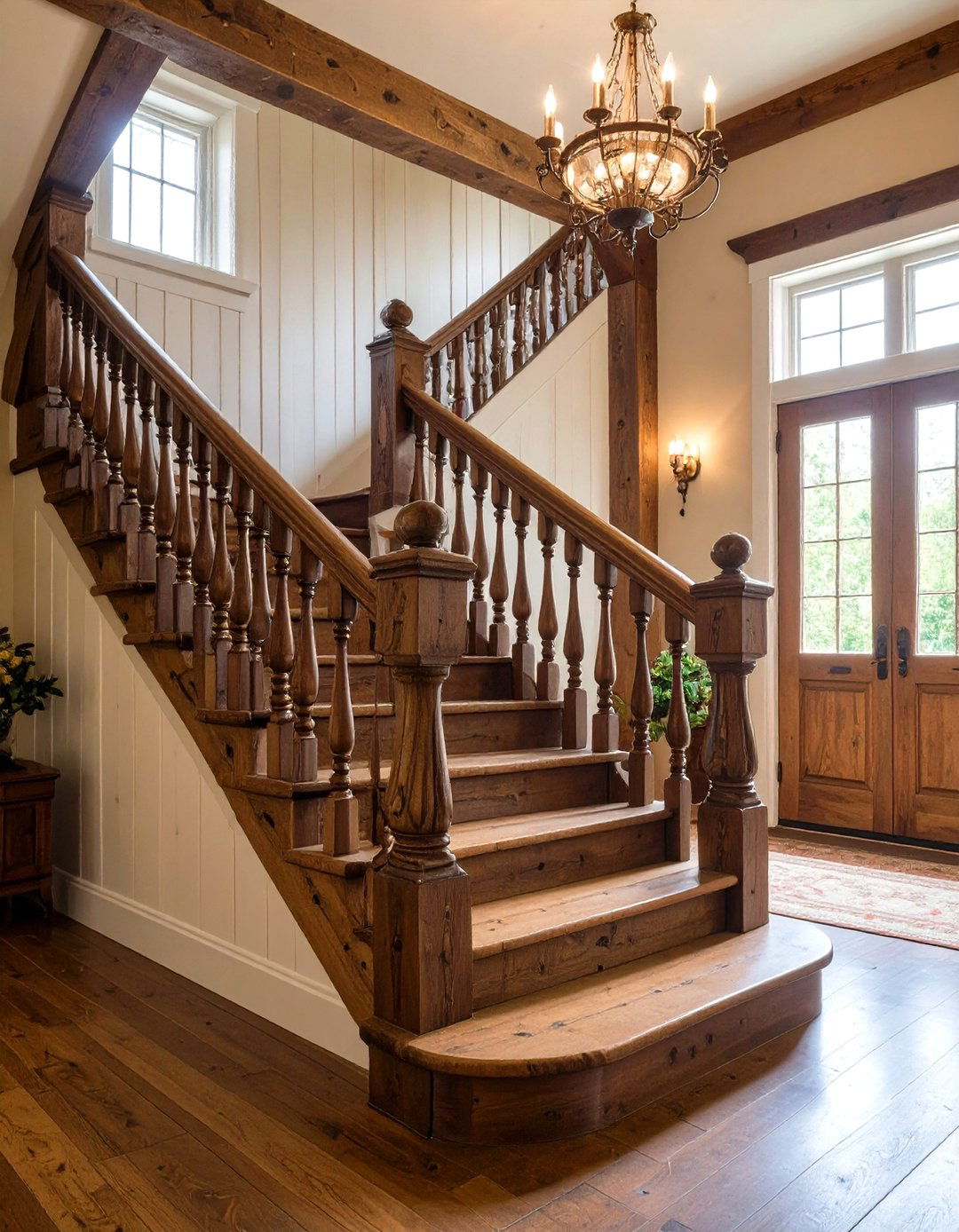
Reclaimed wooden staircases bring history and character into modern homes through authentic weathered materials. This wood staircase is minimal in design, but by using antique wood, which contains its original saw marks and patina, you can quietly complement the rest of the decor. The natural aging process creates unique color variations and texture that cannot be replicated in new lumber. Each piece tells a story through its weathered surface, nail holes, and grain patterns developed over decades of use. One of the best things about natural wood is the way that its color can naturally vary from one piece to the next. This variation adds a lot of depth and interest to a staircase. These staircases work beautifully in rustic homes, converted barns, and spaces seeking authentic vintage charm. The environmental benefits of reusing materials add another layer of appeal for eco-conscious homeowners.
7. Modern Wooden Staircase with Integrated LED Lighting
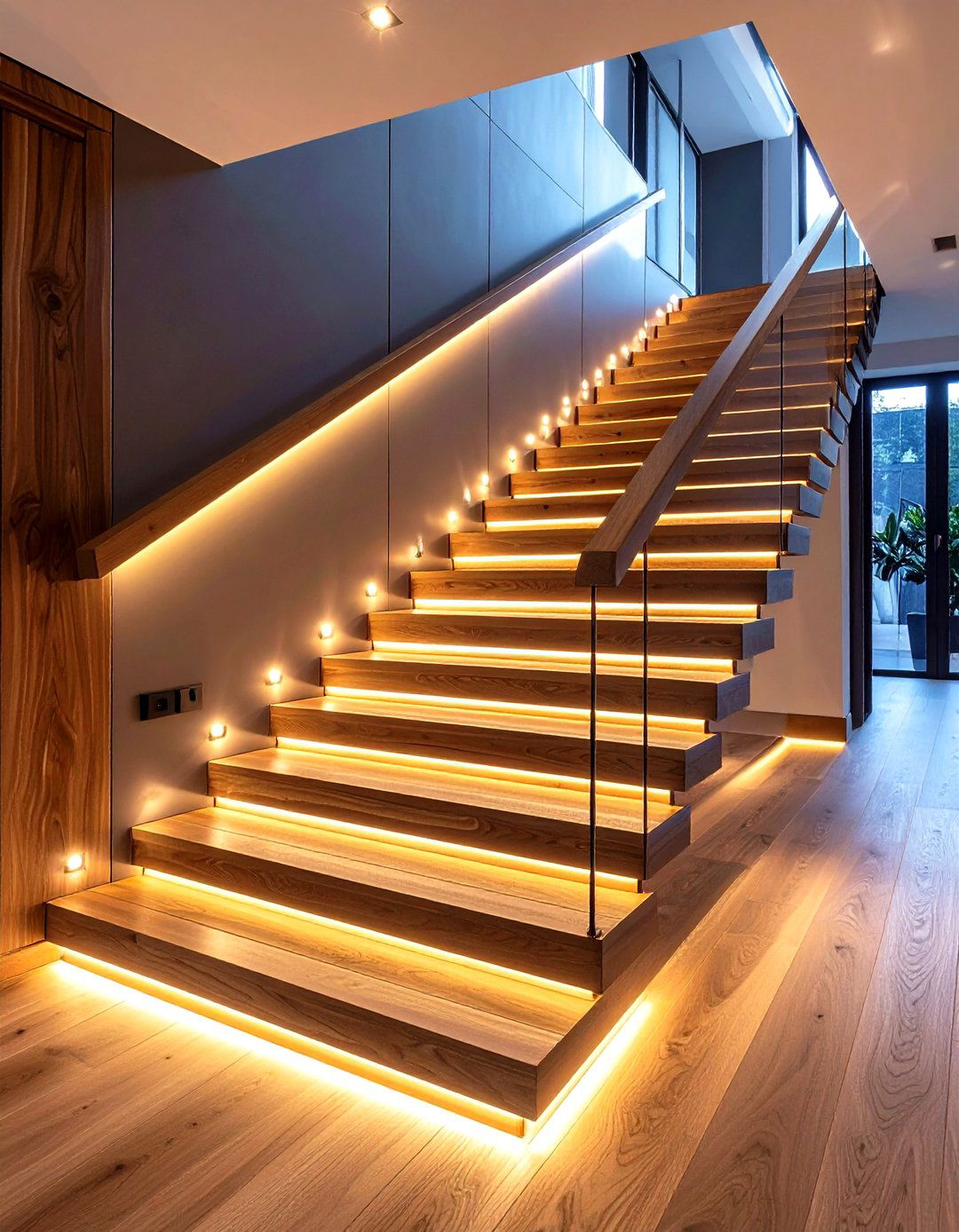
Modern wooden staircases with integrated LED lighting combine functionality with dramatic visual impact. Many modern staircases integrate smart technology, such as LED lighting and motion sensors, enhancing both functionality and safety. The lighting can be embedded within the treads, along the handrails, or underneath each step to create a floating effect. The subtle glow adds class and divine magnificence to the interior. Motion sensors activate the lighting as users approach, providing safety during nighttime navigation while creating stunning ambient lighting during evening hours. The wooden elements, typically in contemporary species like walnut or bleached oak, provide warmth against the cool LED illumination. This technology integration makes staircases safer while transforming them into architectural light sculptures that enhance the overall interior design.
8. Traditional Wooden Staircase with Curved Newel Posts
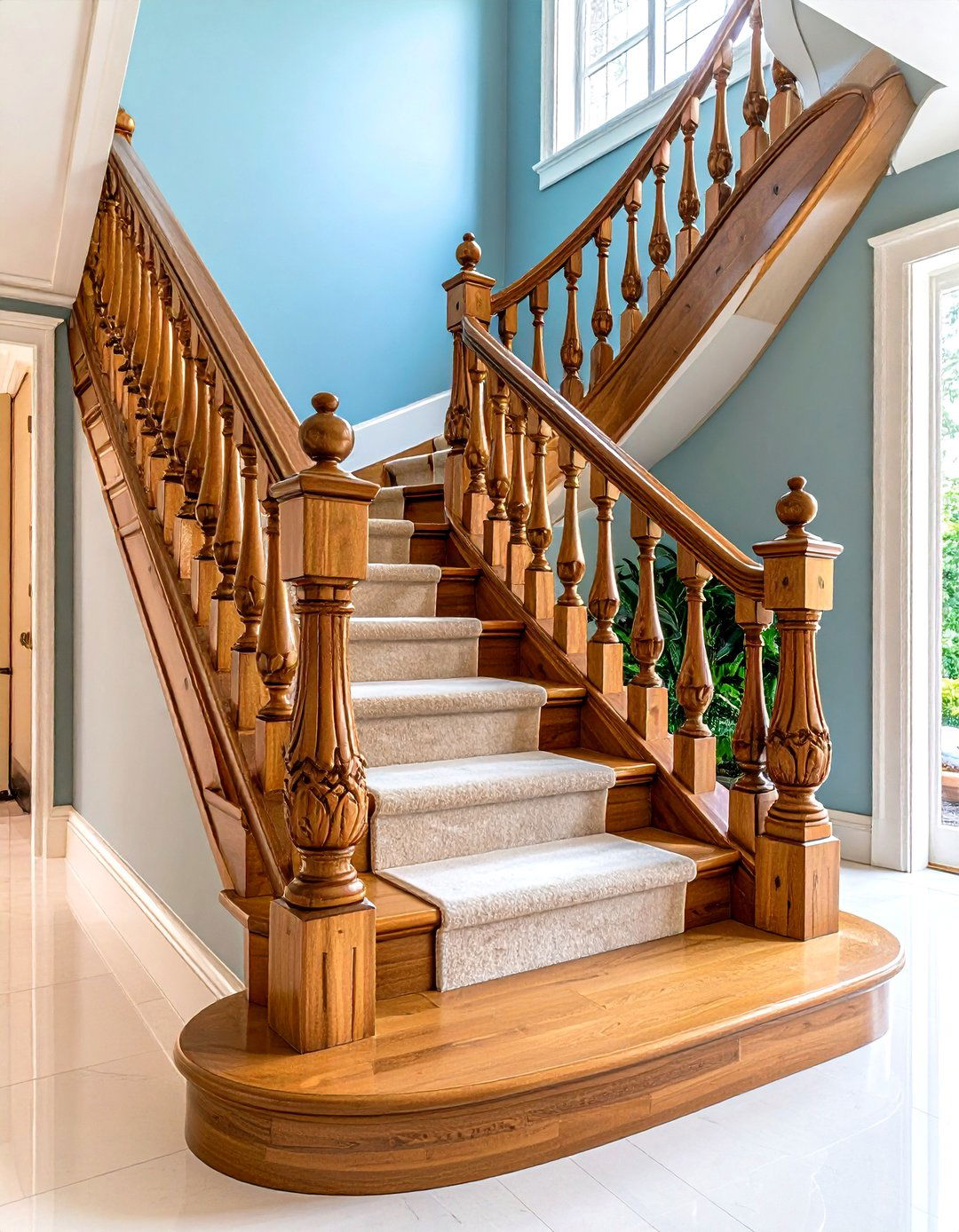
Traditional wooden staircases featuring curved newel posts embody timeless elegance and craftsmanship. A curved wooden handrail from Heather Peterson Design slopes down to meet the floor, replacing a traditional newel post, while metal spindles extend out from the wall instead of securing into the stairs. The newel posts serve as anchor points for the handrail system while providing opportunities for decorative carving and detail work. These substantial wooden elements, often turned on a lathe or hand-carved, showcase traditional woodworking techniques. The curved profiles create graceful transitions between straight handrail sections and stair landings. Incorporating wooden elements, such as oak handrails, can elevate the overall aesthetic of a staircase while enhancing the warmth of a primarily white-painted space. Rich wood species like mahogany, cherry, or oak provide the density and workability necessary for intricate details while ensuring long-lasting durability.
9. Open Riser Wooden Staircase with Minimalist Design
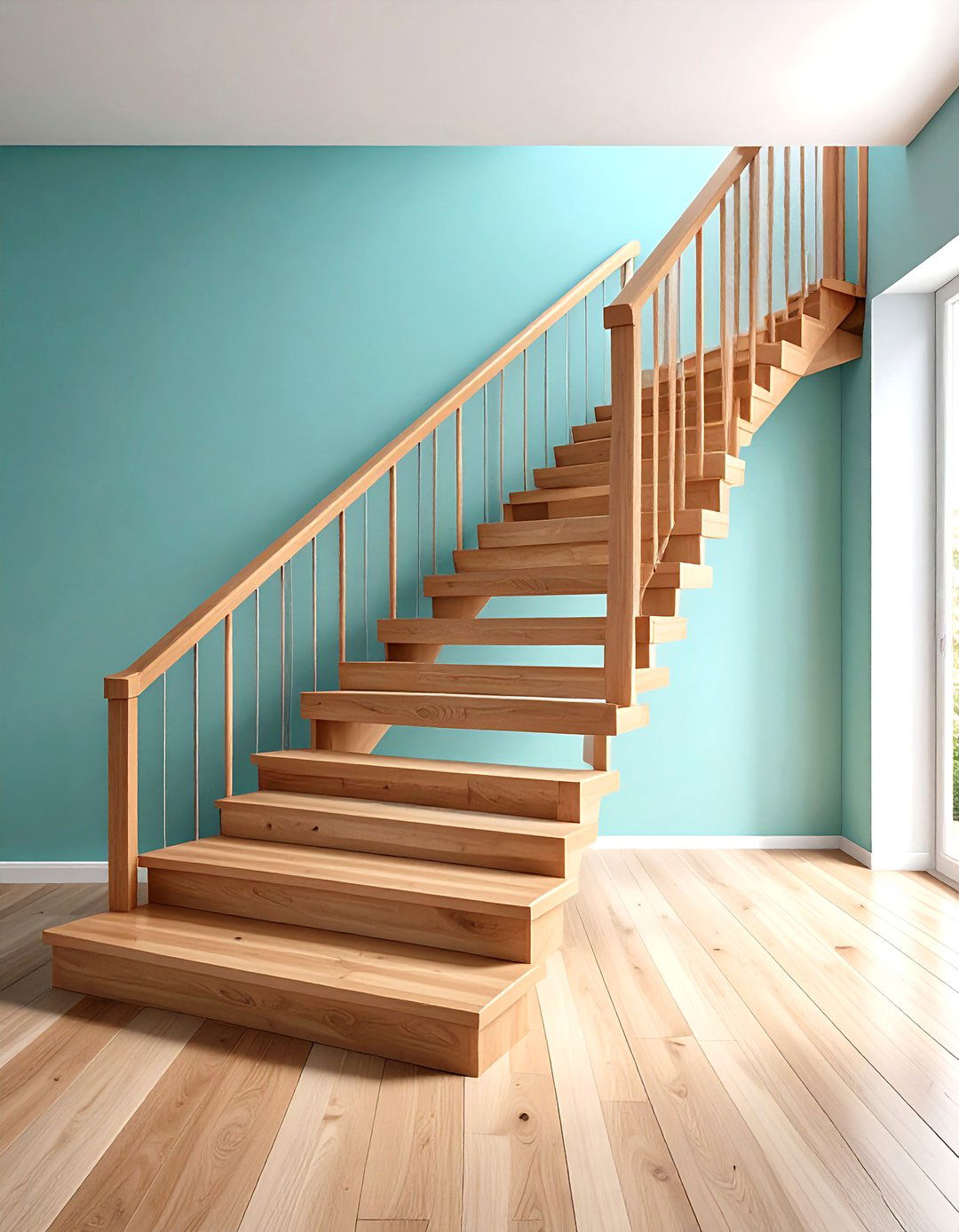
Open riser wooden staircases embrace minimalist design principles while maximizing light flow and visual space. Alternatively, a stair without risers is said to be open, the space behind the staircase is open too, a visible accessible part of the room layout. The absence of vertical risers creates transparency that allows light to filter through the staircase structure. Visual openness: enhance the sense of space in a room, allowing light to flow freely and creating an airy atmosphere. Thick wooden treads, typically 2-3 inches in depth, provide substantial footing while maintaining the clean aesthetic. These designs work exceptionally well in contemporary homes, small spaces, and areas where maintaining visual continuity between levels is important. The open design also creates opportunities for creative under-stair storage solutions or reading nooks, maximizing the functional use of space.
10. L-Shaped Wooden Staircase with Landing Platform
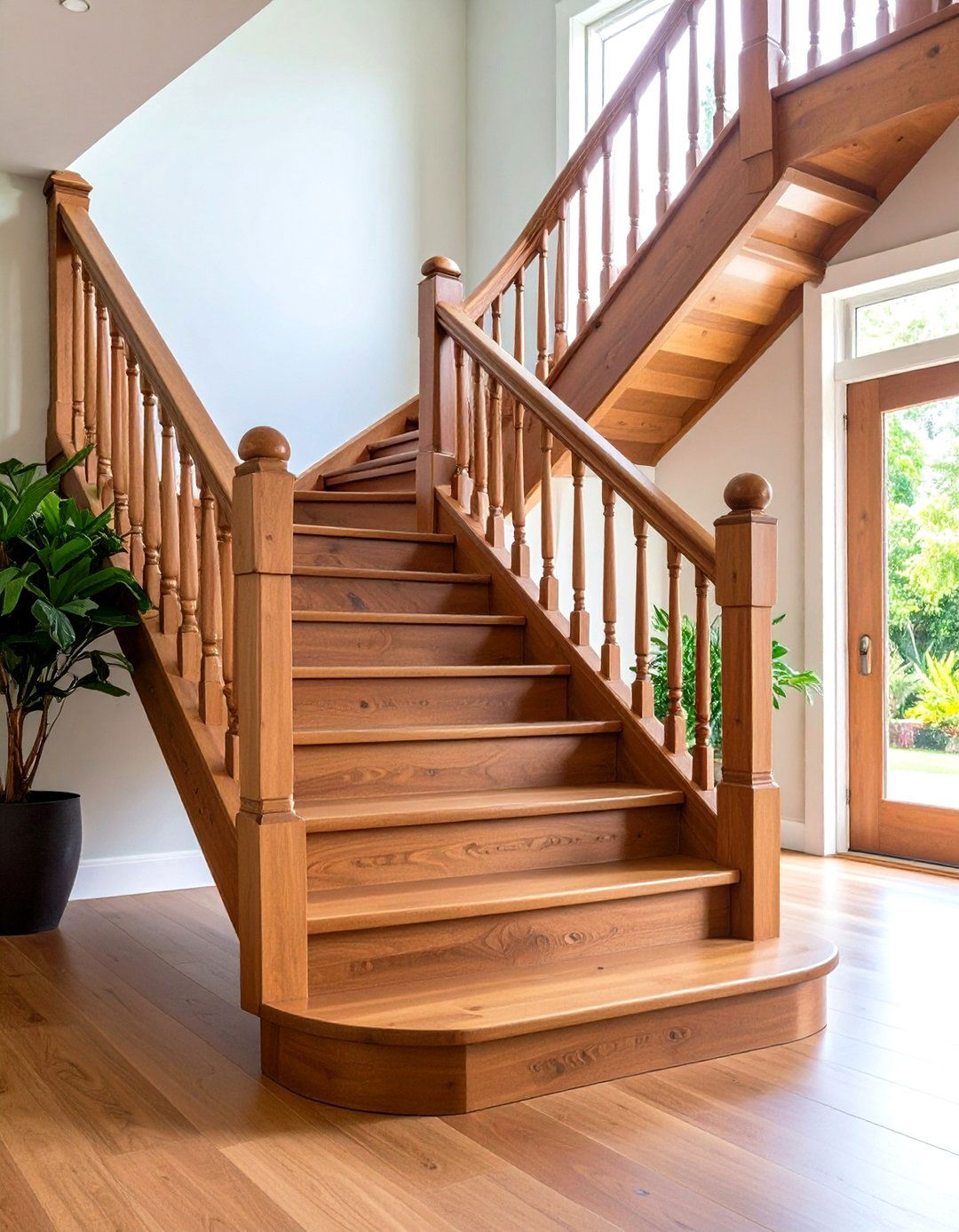
L-shaped wooden staircases with landing platforms provide practical solutions for homes with specific spatial constraints. U-shaped staircases can effectively utilize space, making them ideal for both smaller and larger homes by creating a visually interesting flow between different levels. The landing platform creates a natural resting point during ascent while providing opportunities for decorative elements or seating areas. These intermediate platforms can accommodate furniture, artwork, or plants that enhance the staircase's visual appeal. The wooden construction typically features consistent materials throughout, from treads to handrails, creating visual continuity. The design allows for the integration of bespoke storage under the stairs, maximizing functionality in often underutilized areas of the home. The L-configuration works particularly well in entryways and can create dramatic architectural statements when combined with high ceilings and natural lighting.
11. Wooden Staircase with Painted Contrast Risers
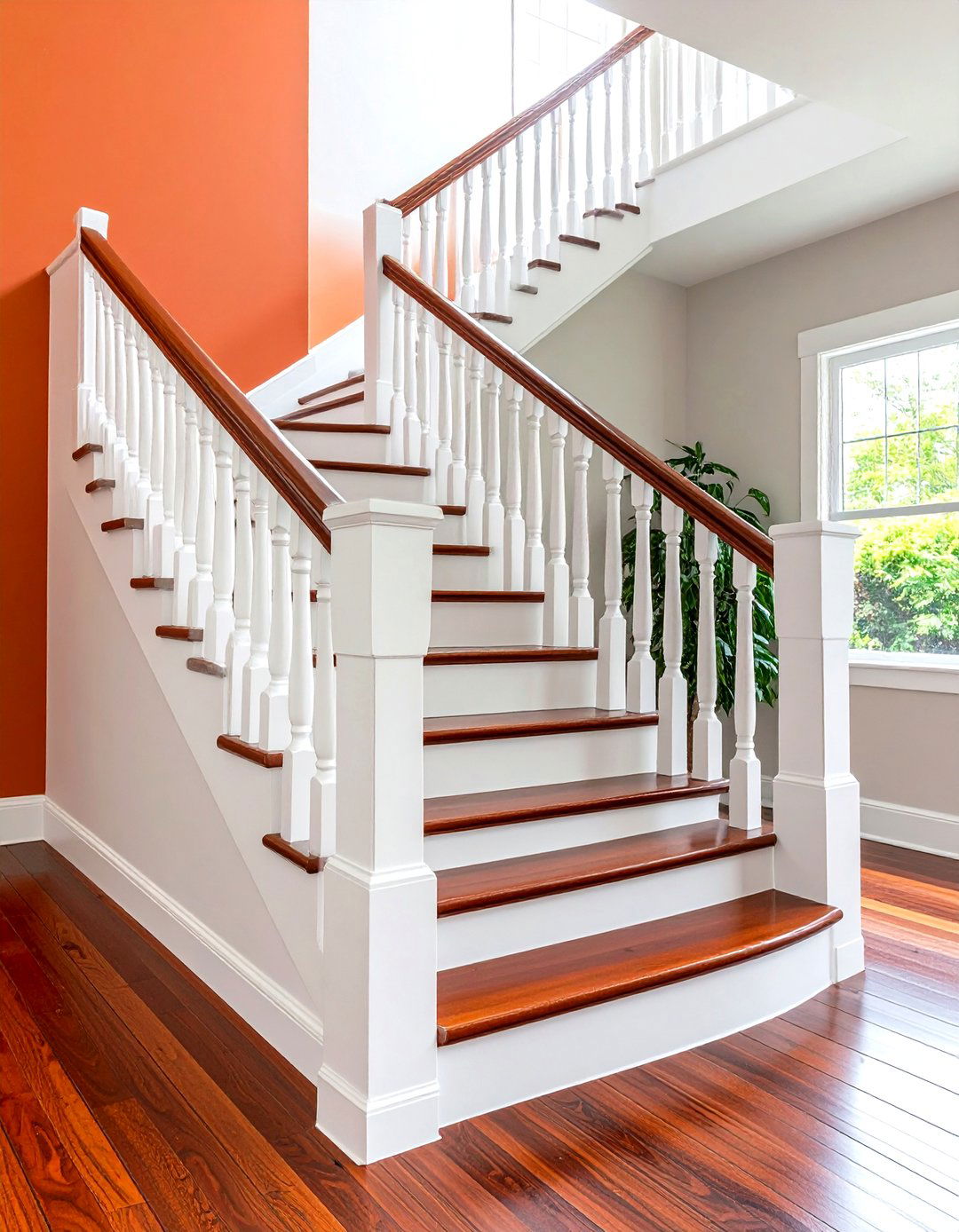
Wooden staircases with painted contrast risers create visual depth while adding personality to functional spaces. Having contrasting colors between the risers and the treads is not only visually appealing, but is a practical design choice. Painting the risers white creates depth and dimension to break up the red oak hardwood stairs. The painted risers, typically in white or bold colors, provide contrast against natural wood treads while making the stairs easier to navigate safely. Using high-gloss or semi-gloss latex white paint on the risers is easy to clean and can hide scuff marks or smudges. This design approach allows homeowners to introduce color into their interiors while maintaining the warmth of natural wood. Adding peel-and-stick wallpaper to stair risers is an easy weekend project that can change the whole look of your staircase. The technique works with various design styles from farmhouse to contemporary.
12. Curved Wooden Staircase with Sweeping Handrails

Curved wooden staircases with sweeping handrails create graceful architectural statements that command attention. Curved staircases offer an elegant and space-saving solution, making them a popular choice for modern home designs. The flowing lines require expert craftsmanship to achieve smooth curves in both the structural framework and decorative elements. This wide front hall has plenty of room for a winding staircase. The stair runner softens the look of the wooden risers, while a dark wood railing draws the eye up and around the shapely curve of the stairs. Laminated wood construction techniques allow handrails to follow complex curves while maintaining structural integrity. The curved design creates dynamic visual interest from multiple viewing angles while maximizing the use of available space. These staircases work particularly well in grand entryways, multi-story atriums, and homes where the staircase serves as a central design feature.
13. Rustic Wooden Staircase with Live Edge Treads
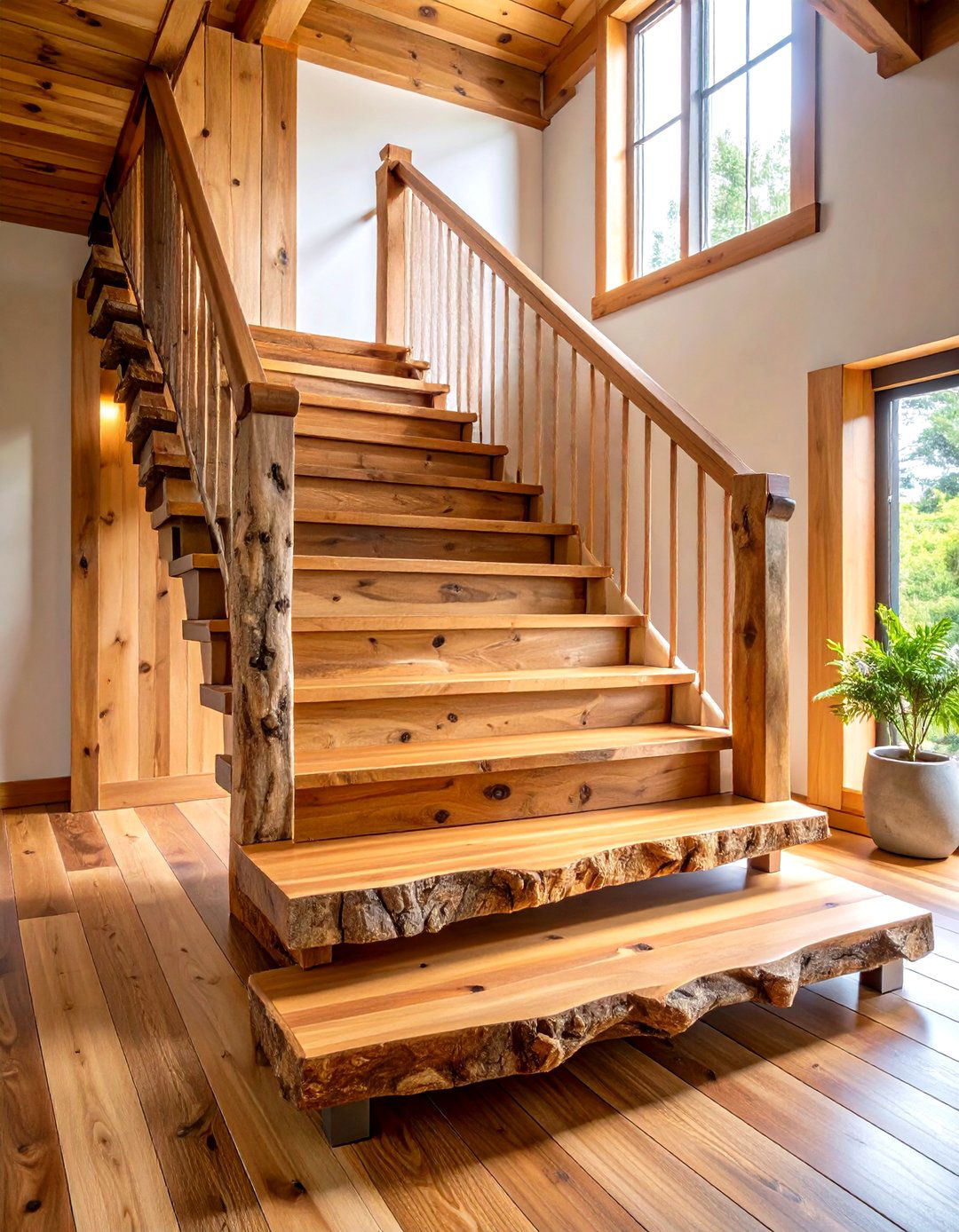
Rustic wooden staircases featuring live edge treads celebrate the natural beauty of unprocessed lumber. Wooden slabs used as stair treads often convey a country feel. But these clean-lined risers give off an undeniable contemporary look. Live edge construction preserves the natural bark edge and irregular contours of the original tree, creating unique organic shapes for each tread. The natural variations in width and curve ensure that no two steps are identical, adding visual interest and authentic rustic character. These treads typically require substantial support structures due to their thickness and weight, often utilizing steel or heavy timber frameworks. The contrast between refined support systems and raw natural edges creates compelling design tension. The rich color of the stairs offers a nice contrast to the cool tones of the rest of the room, warming up the design and adding some character and interest to the area. Perfect for cabins, mountain homes, and contemporary spaces seeking natural authenticity.
14. Wooden Staircase with Built-in Storage Solutions

Wooden staircases with built-in storage solutions maximize functionality while maintaining aesthetic appeal in space-conscious homes. Maximize storage: the enclosed space is ideal for built-in storage, such as closets, cabinets, or utility areas. The area beneath staircases traditionally represents underutilized space that can be transformed into practical storage solutions. Custom cabinetry can be integrated seamlessly into the staircase design, providing hidden storage for books, seasonal items, or household supplies. Spacing between the risers and treads of the staircase creates room for storage. Pull-out drawers, built-in shelving, and concealed compartments can be incorporated without compromising the staircase's structural integrity. These designs work particularly well in small homes, apartments, and spaces where every square foot must serve multiple purposes. The wooden construction can match existing cabinetry and flooring for visual continuity throughout the interior.
15. Double-Stringer Wooden Staircase with Central Support
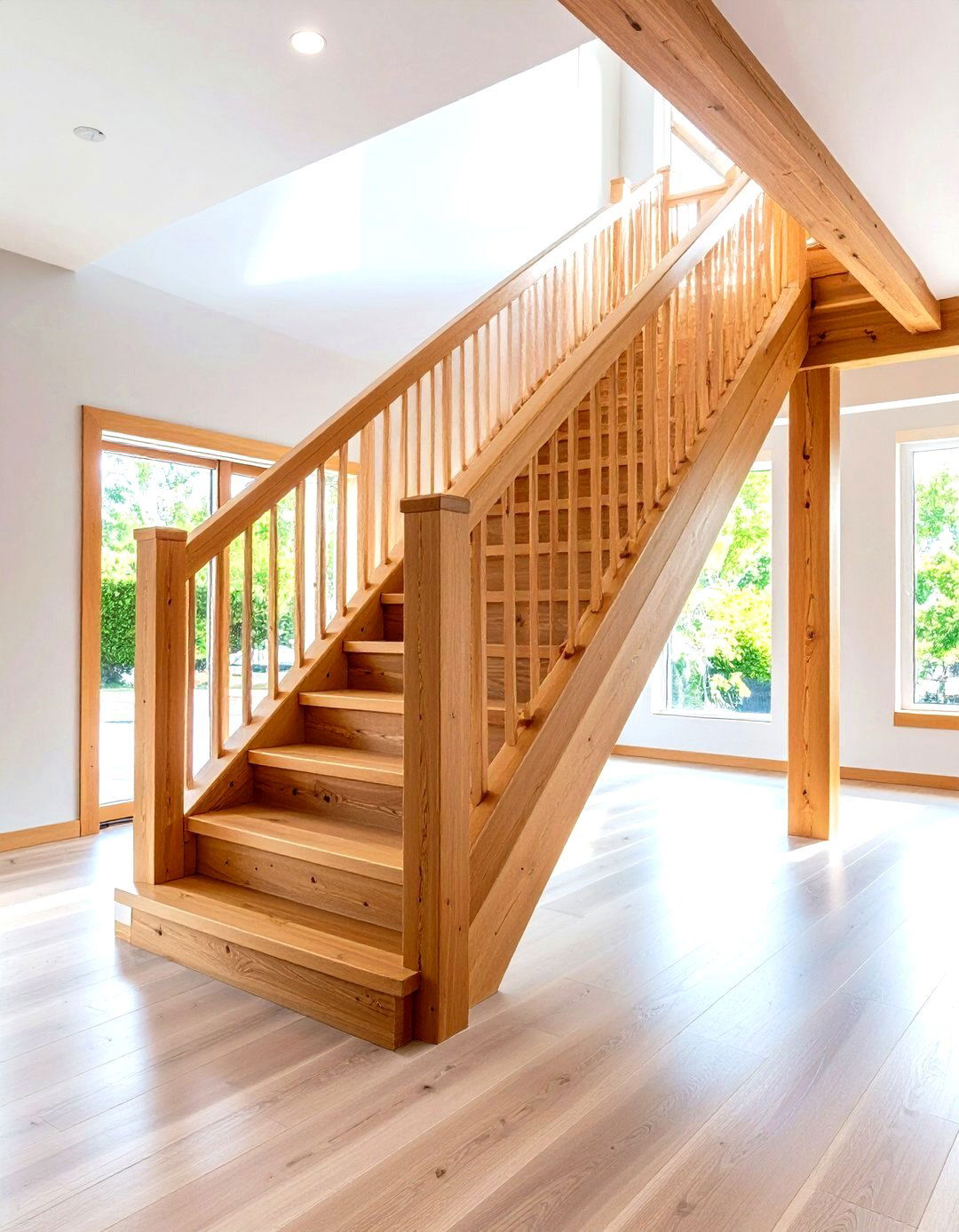
Double-stringer wooden staircases with central support offer robust construction while maintaining clean aesthetic lines. A dual-stringer staircase is designed with two beams supporting the treads of a floating staircase. The central support system distributes weight evenly while allowing for longer spans between support points. Pairing the strength of two support beams with the open modern designs and clean lines of a floating staircase, this dual stringer straight staircase is a great choice. The double-stringer configuration provides enhanced stability for high-traffic areas while maintaining the visual lightness associated with floating designs. Steel or engineered lumber stringers can be clad in matching wood to maintain aesthetic continuity. The thickness of the solid 16/4 maple treads balances out the hefty Douglas fir support beams. This construction method works well in commercial applications, large homes, and spaces requiring enhanced load-bearing capacity without sacrificing contemporary design sensibilities.
16. Wooden Staircase with Decorative Baluster Patterns
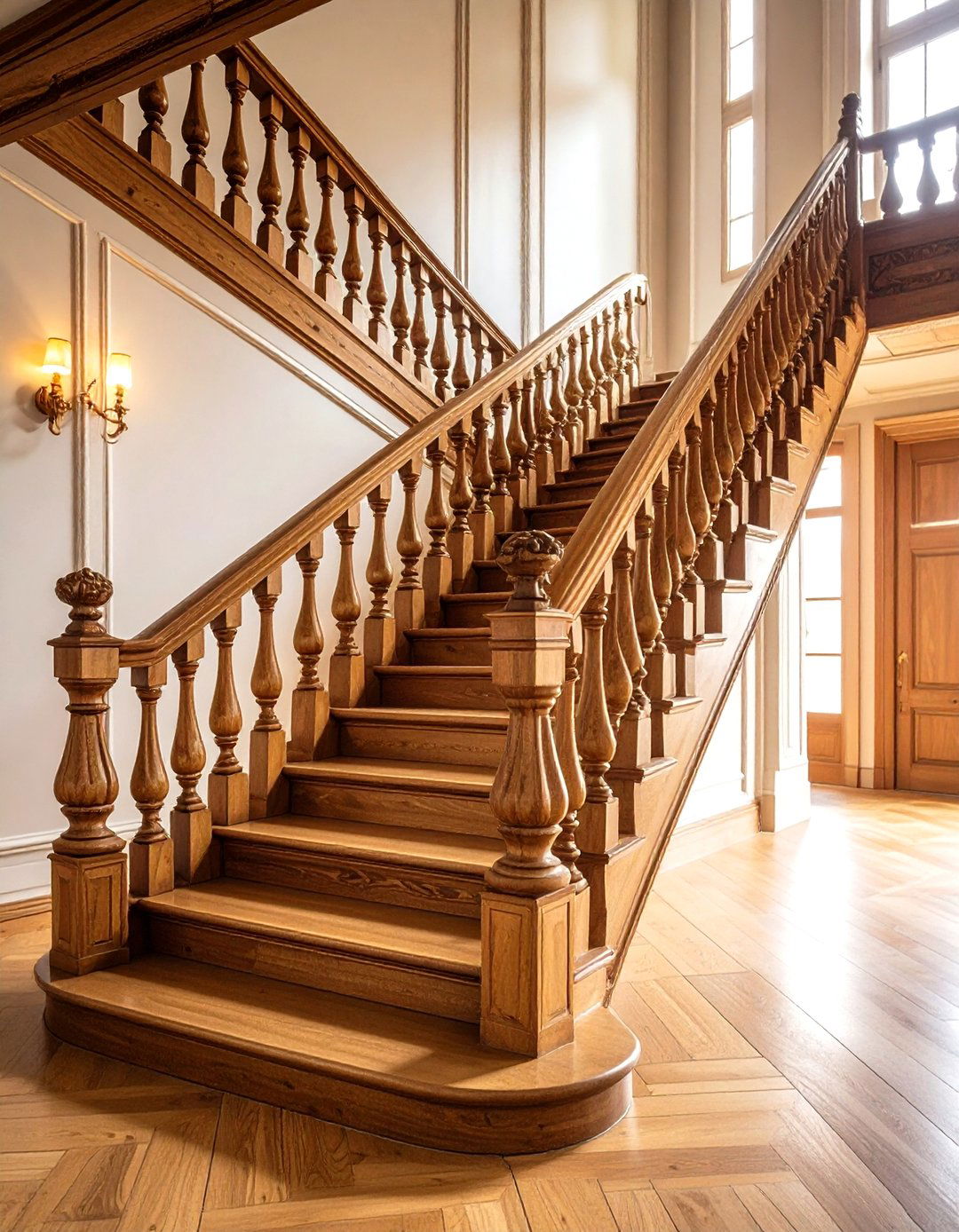
Wooden staircases with decorative baluster patterns showcase traditional craftsmanship while providing safety and visual interest. Anne McDonald Design used carefully cut wooden pieces to create a pretty, unexpected design that replaces slimmer spindles. Custom baluster designs can incorporate geometric patterns, traditional turning profiles, or contemporary interpretations of classical elements. The wooden balusters, typically made from the same species as the handrails and treads, create visual continuity throughout the staircase system. Opt for a decorative iron railing to conjure the feeling of Spanish-style homes. Light colors on the rest of the stairs creates contrast against the railing and balusters. Intricate spacing patterns, alternating designs, and varied heights create dynamic visual rhythms. These details require skilled woodworking techniques including turning, carving, and precise joinery. The decorative elements can be painted, stained, or left natural depending on the desired aesthetic outcome.
17. Wooden Staircase with Wire Cable Safety Railings
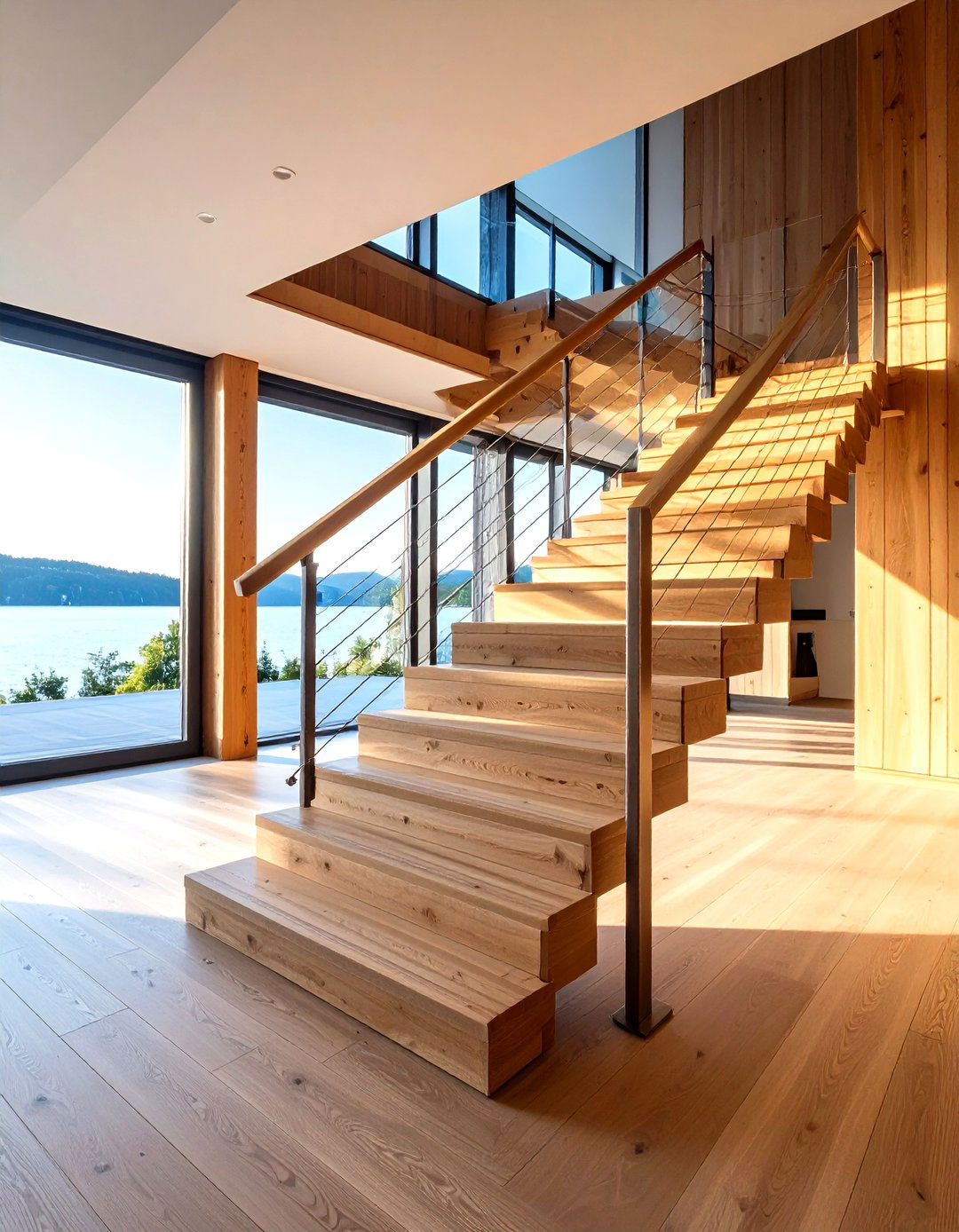
Wooden staircases with wire cable safety railings combine natural warmth with contemporary safety standards. An oversized window, light wood tones, and nearly invisible wire railings keep this staircase, designed by Nash Design Group, light and bright. The thin cable profiles maintain sight lines while meeting building code requirements for railing height and spacing. Stainless steel cables stretch between wooden posts, creating minimal visual obstruction while providing necessary safety barriers. The railing features "Sparkling Silver" powder-coated steel posts, an aluminum top rail, and an ADA-compliant handrail. The cable systems allow natural light to flow freely through the staircase structure, making spaces feel larger and more open. Wooden handrails provide comfortable gripping surfaces while the cable infill maintains the contemporary aesthetic. This combination works exceptionally well in modern homes, lakeside properties, and spaces where maintaining views is essential to the design concept.
18. Traditional Wooden Staircase with Runner Carpeting
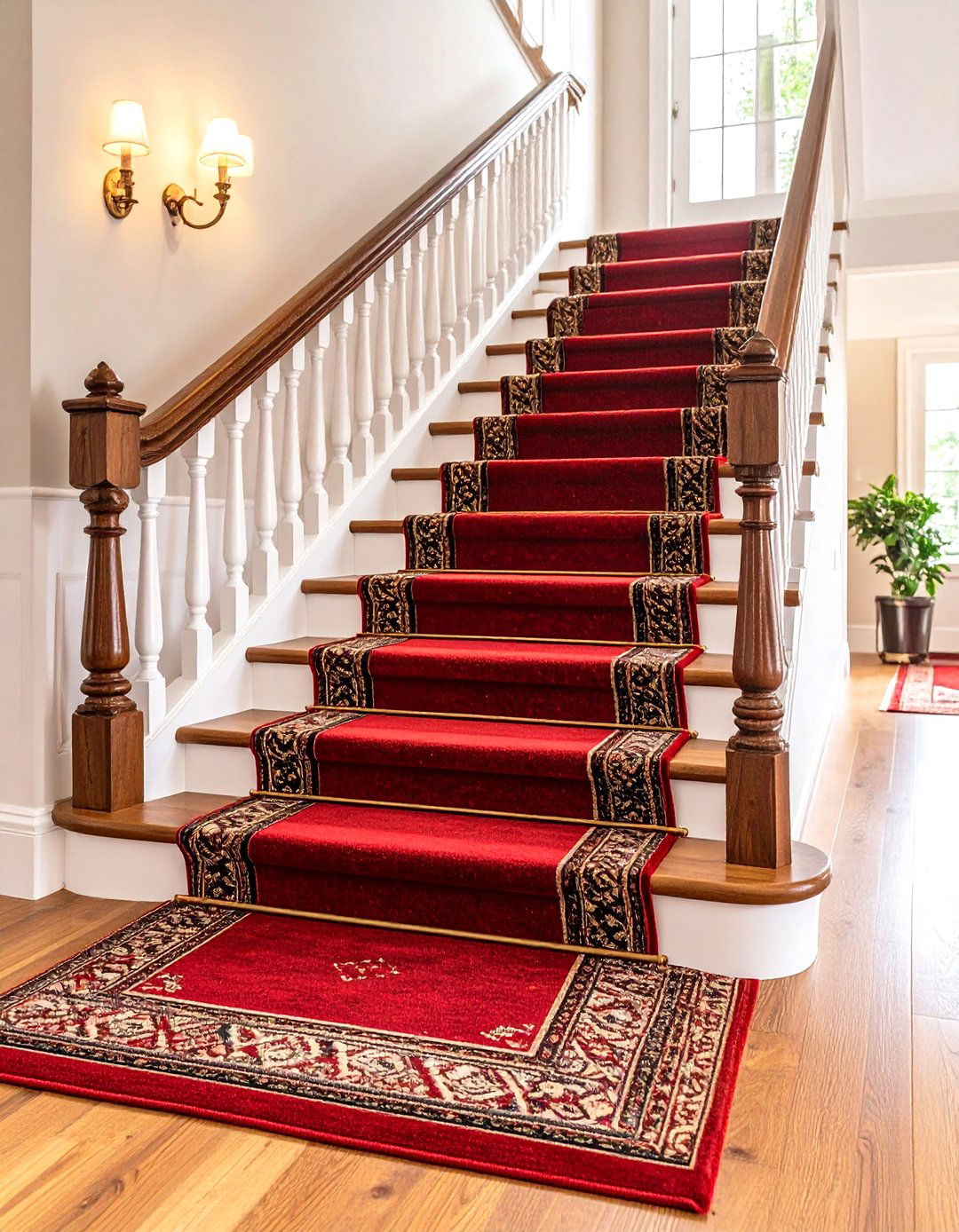
Traditional wooden staircases with runner carpeting combine classic elegance with practical comfort benefits. A geometric-pattern stair runner boosts both the comfort and style of this staircase. In addition to providing softness and warmth underfoot, the runner also prevents walkers from slipping on the potentially slick wooden treads. The carpet runners provide acoustic dampening, reducing footstep noise while adding visual interest through pattern and color. Install a bold runner to dress up a simple staircase like this one. Classic plaid speaks to the traditional style of the staircase design while adding a fun dose of personality. Runners can be secured with decorative rods or tackless strips, allowing for easy removal and replacement. The exposed wooden edges create beautiful borders that showcase the natural wood grain and craftsmanship. Various patterns from traditional florals to contemporary geometrics can complement different interior design styles while providing safety and comfort benefits.
19. Wooden Staircase with Accent Wall Gallery
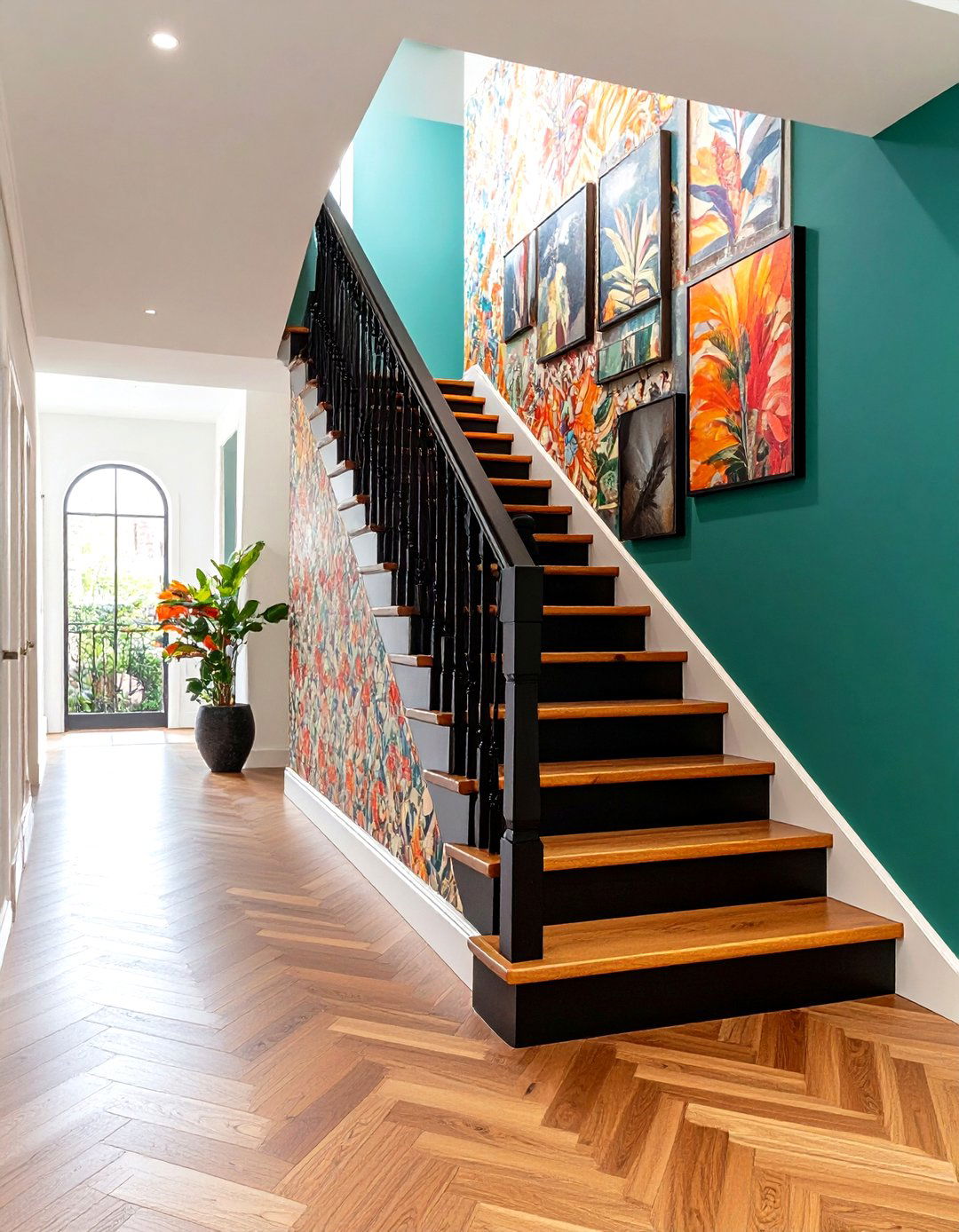
Wooden staircases with accent wall galleries transform functional circulation spaces into personalized art displays. Designate the wall behind the stairs to serve as an accent by painting it or covering it with a patterned wallpaper that's different from the other surrounding walls. The vertical wall space alongside staircases provides excellent opportunities for curated photo collections, artwork displays, or decorative wall treatments. Gallery walls are excellent staircase decorating ideas since you'll likely have a long stretch of space to work with, plus they're a great way to finally display all those family photos or vacation snapshots. The ascending angles create dynamic display opportunities that change perspective as viewers move up or down the stairs. Careful lighting design can highlight artwork while providing safe illumination for stair navigation. Stick to photo frames and artwork with a slim profile so that you aren't knocking into them while walking up and down the stairway.
20. Wooden Staircase with Mixed Material Handrail Systems
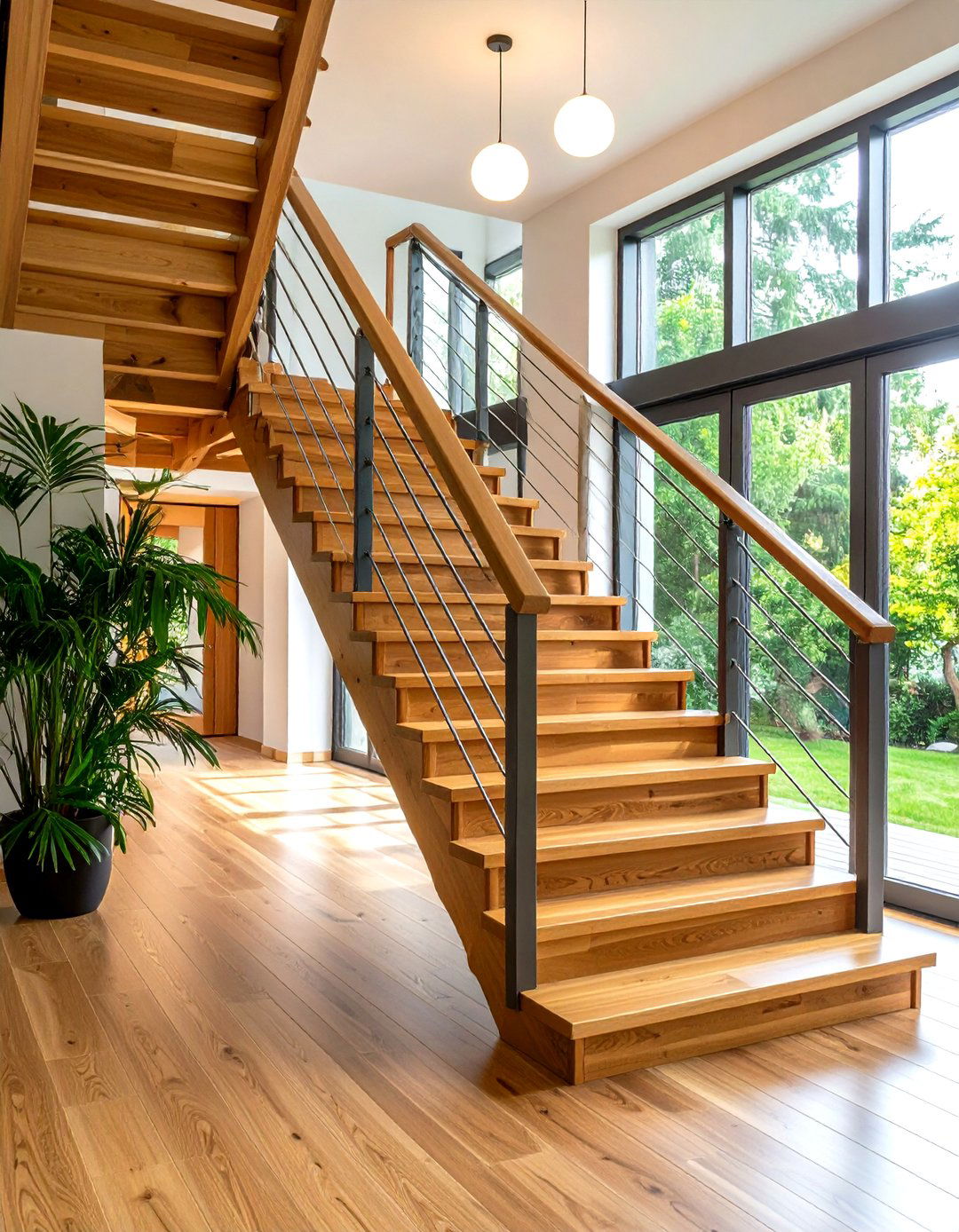
Wooden staircases with mixed material handrail systems create sophisticated design statements through thoughtful material combinations. Mixing metal and wood is a nice way to add some variety to your interiors. The combination might include wooden handrails supported by metal posts, glass panels with wooden caps, or cable systems with timber framing. A combination of wood and metal railings creates an elegant, cozy atmosphere. This style is optimal for houses with a staircase near the main entrance, offering a welcoming first impression to guests. Each material brings distinct properties: wood provides warmth and comfort, metal offers strength and durability, while glass maintains visual transparency. The design for the handrail is based on the railing found in the original home. Custom steel railing is capped with a custom white oak handrail. The material transitions must be carefully detailed to ensure structural continuity and aesthetic harmony. These designs work well in transitional interiors that blend traditional and contemporary elements.
Conclusion:
Wooden staircases offer unlimited design possibilities that can enhance any home's architectural character while providing essential vertical circulation. From floating modern designs to traditional crafted elements, each approach brings unique benefits and aesthetic appeal. Whether you're a professional looking for design inspiration, or planning your own stair and want to be well informed going into such a major undertaking, these twenty ideas demonstrate the versatility and timeless appeal of wooden staircase construction. Consider your home's existing style, spatial constraints, and functional requirements when selecting the perfect wooden staircase design that will serve your family for generations while adding lasting value to your property.




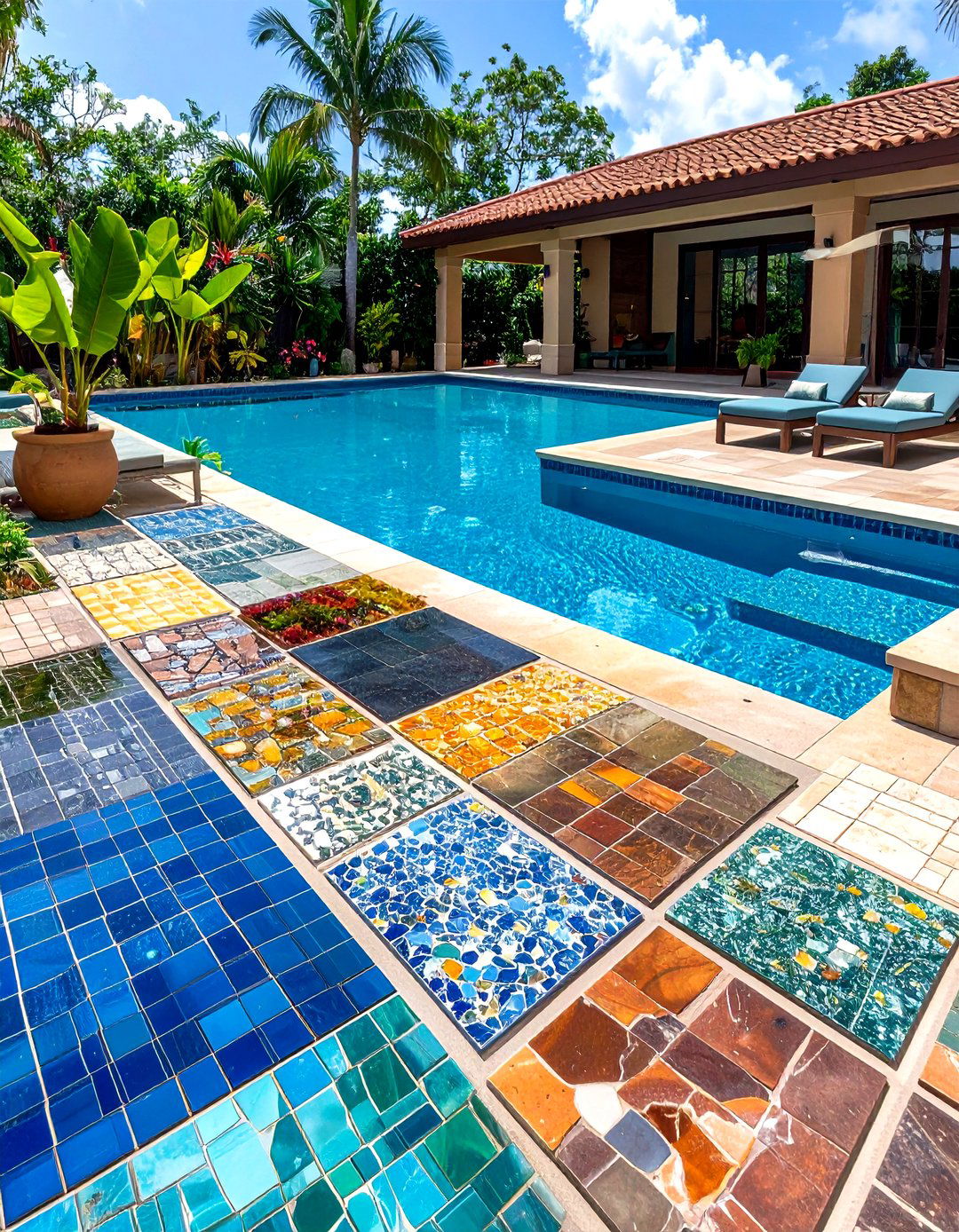
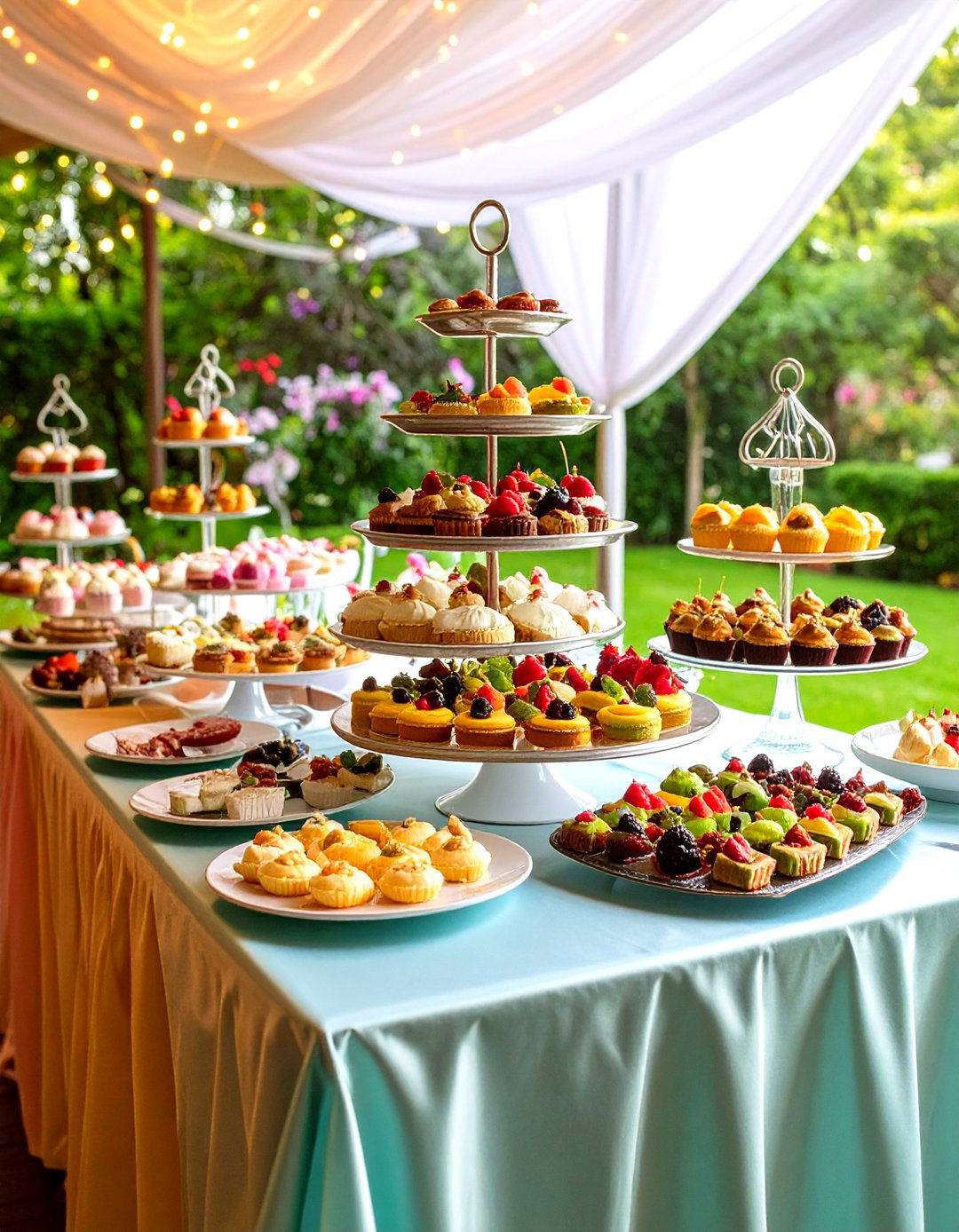
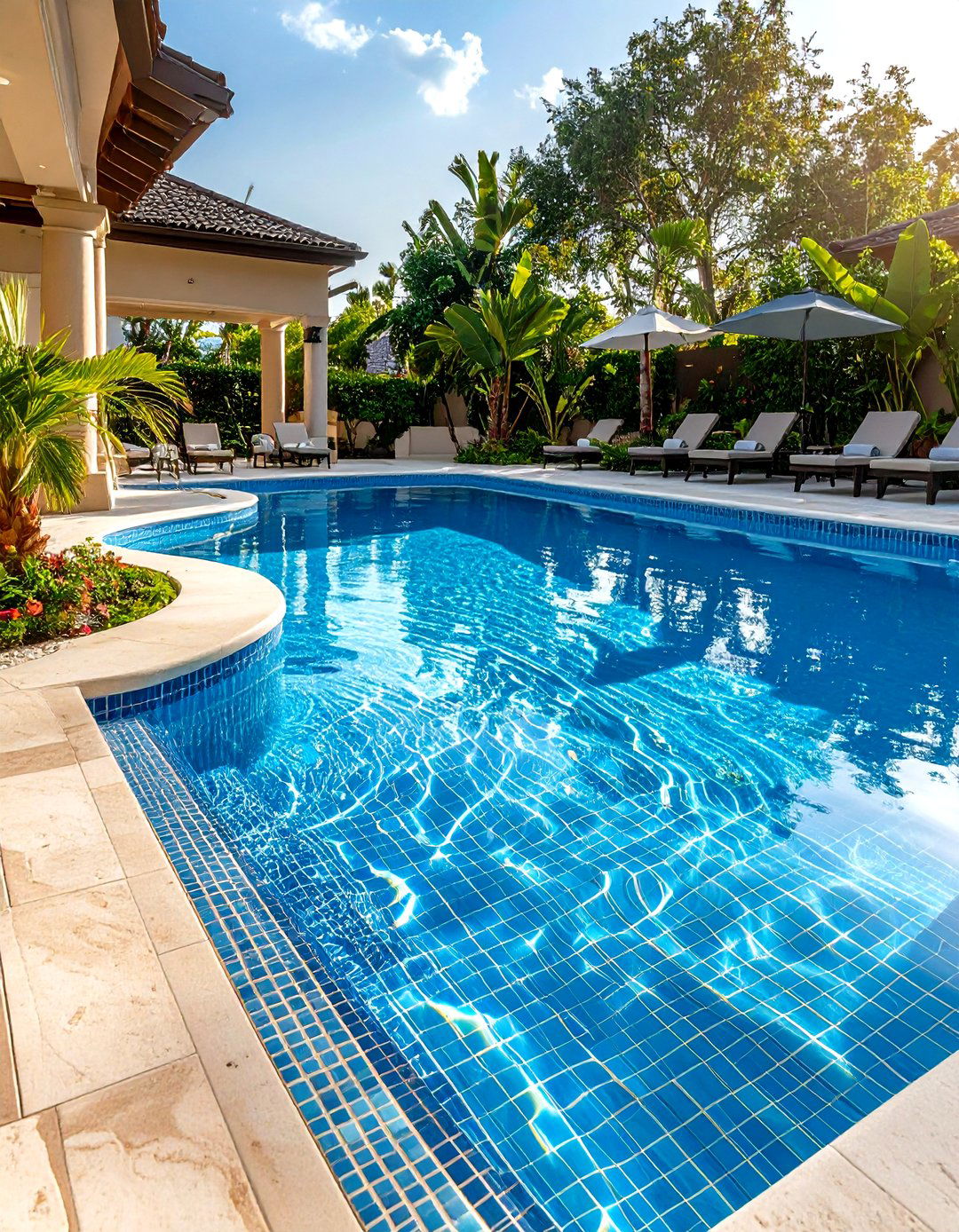
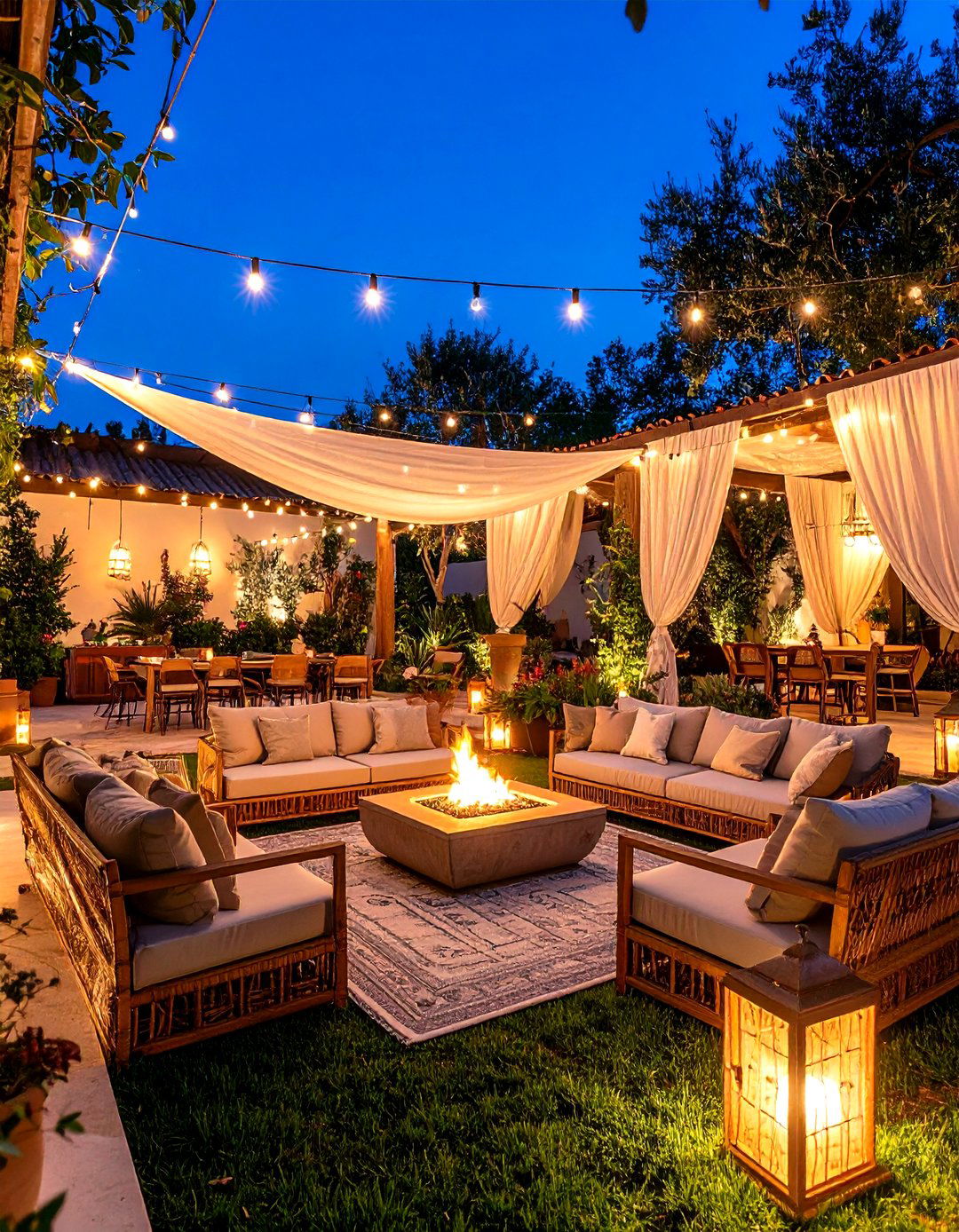
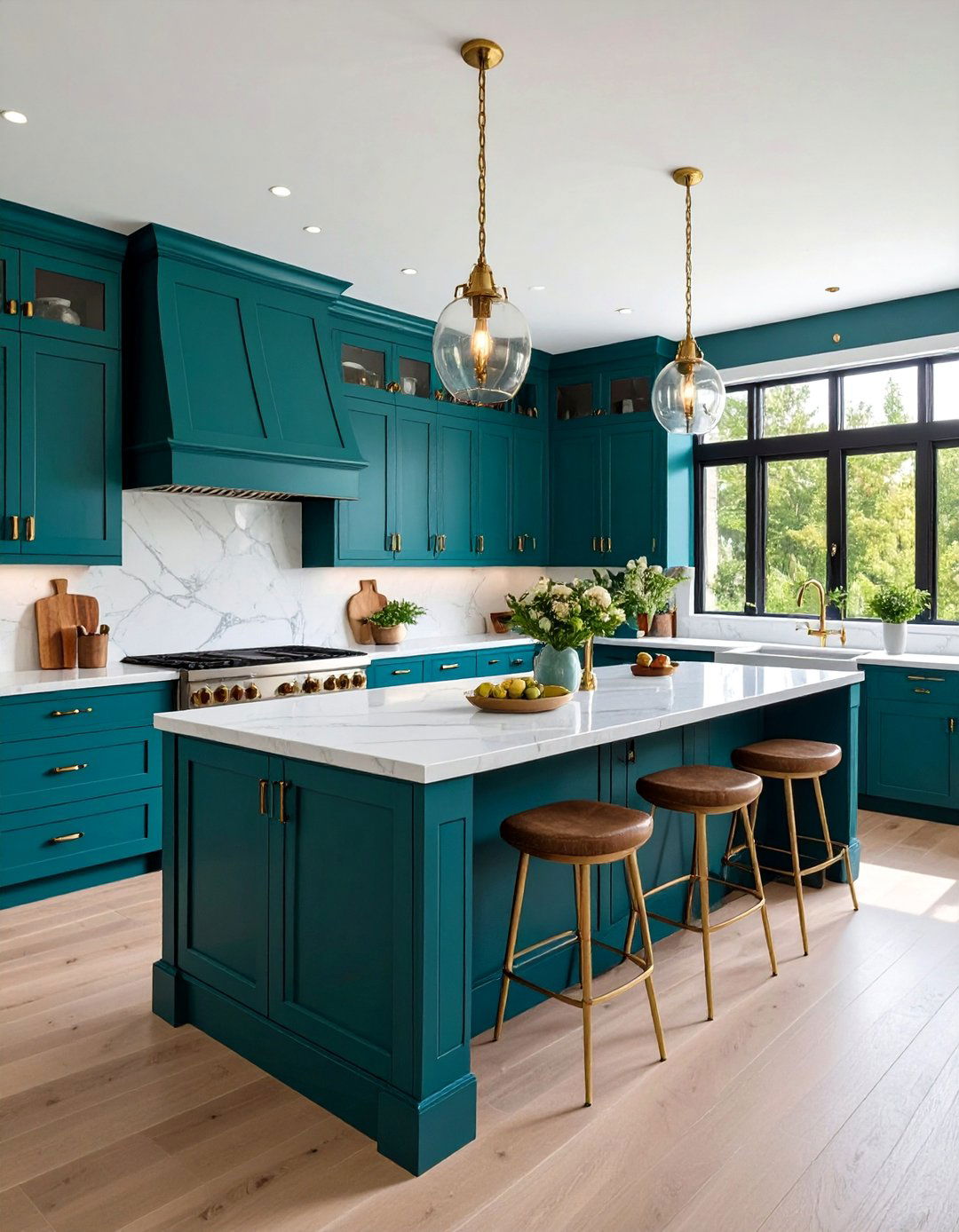
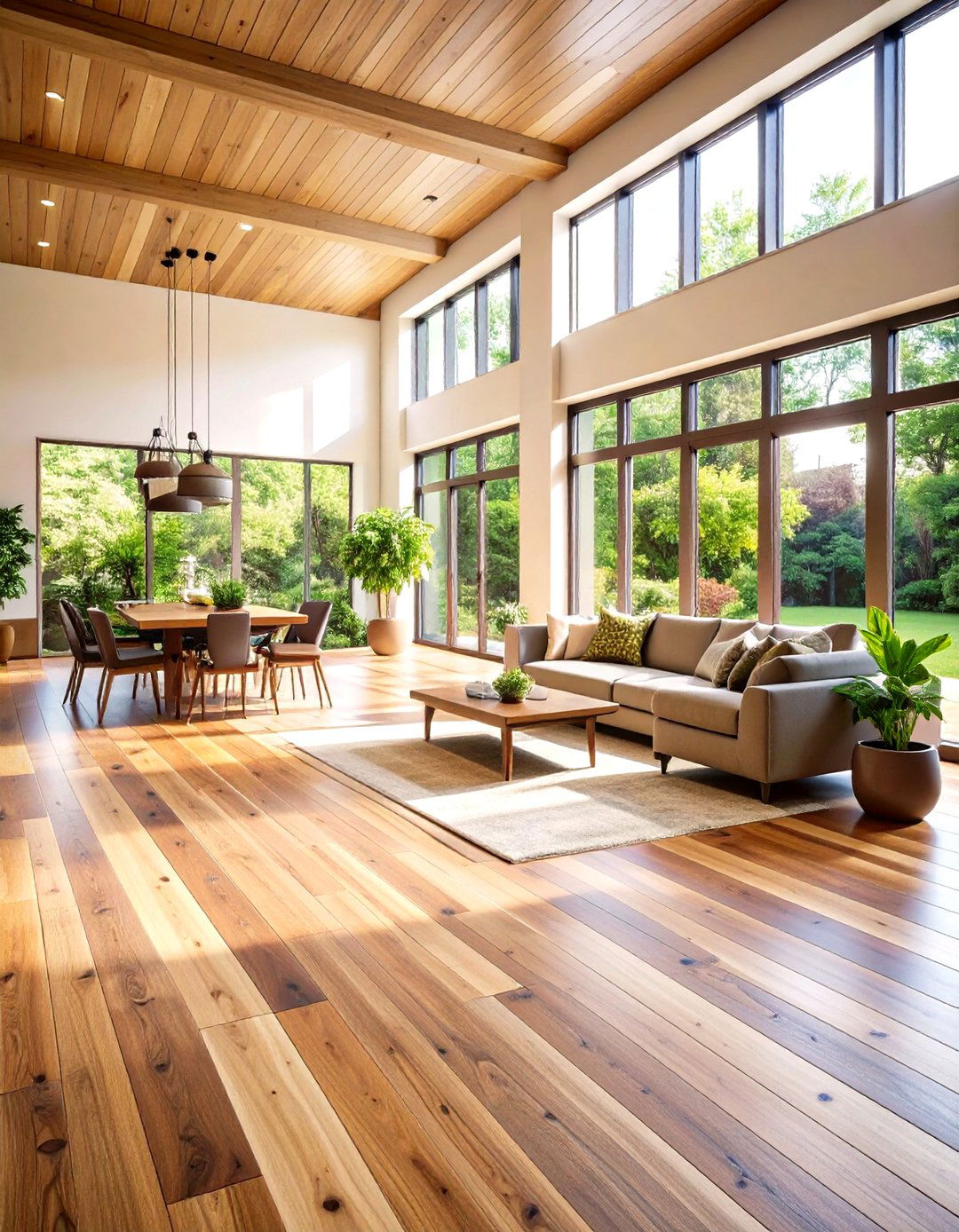

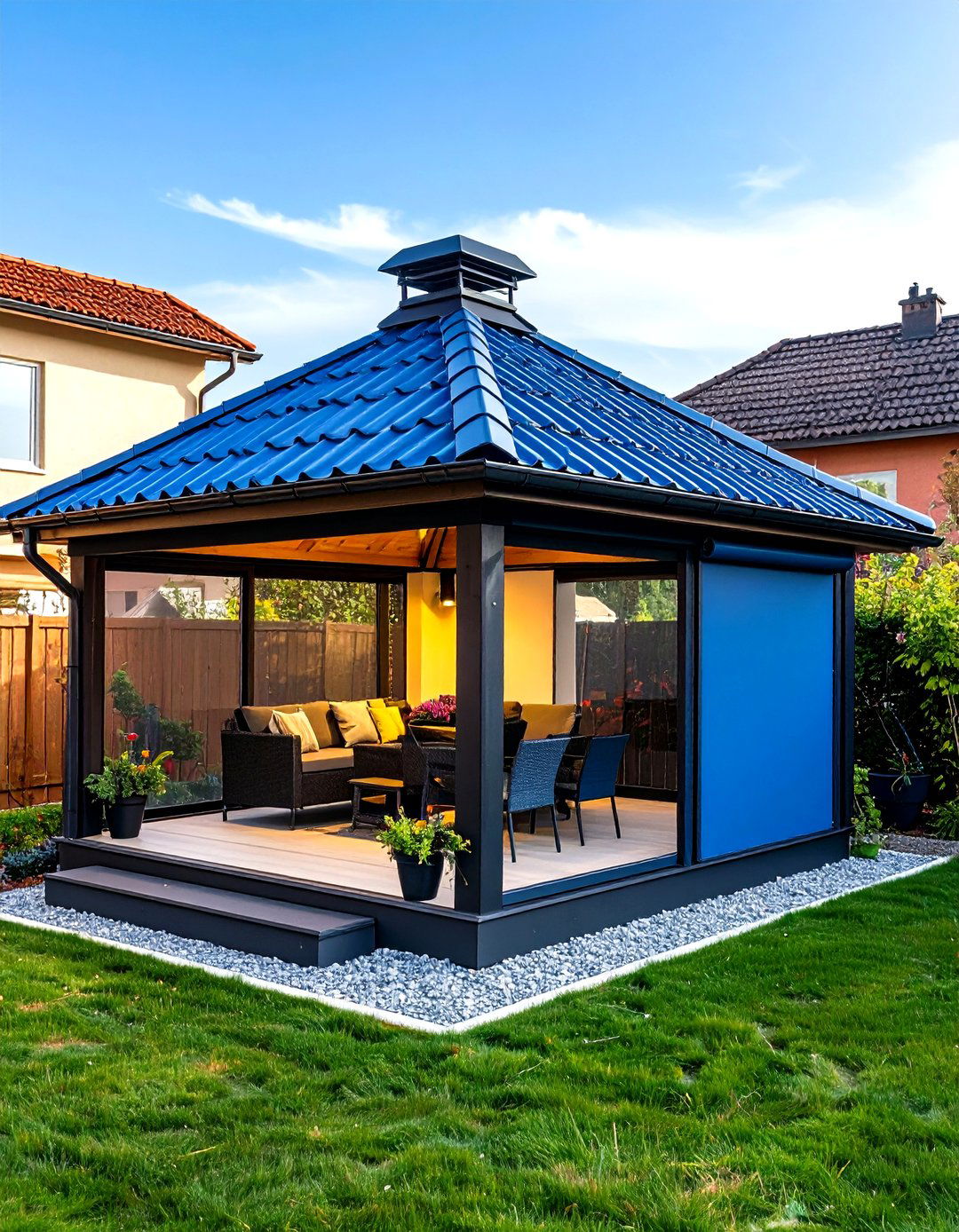
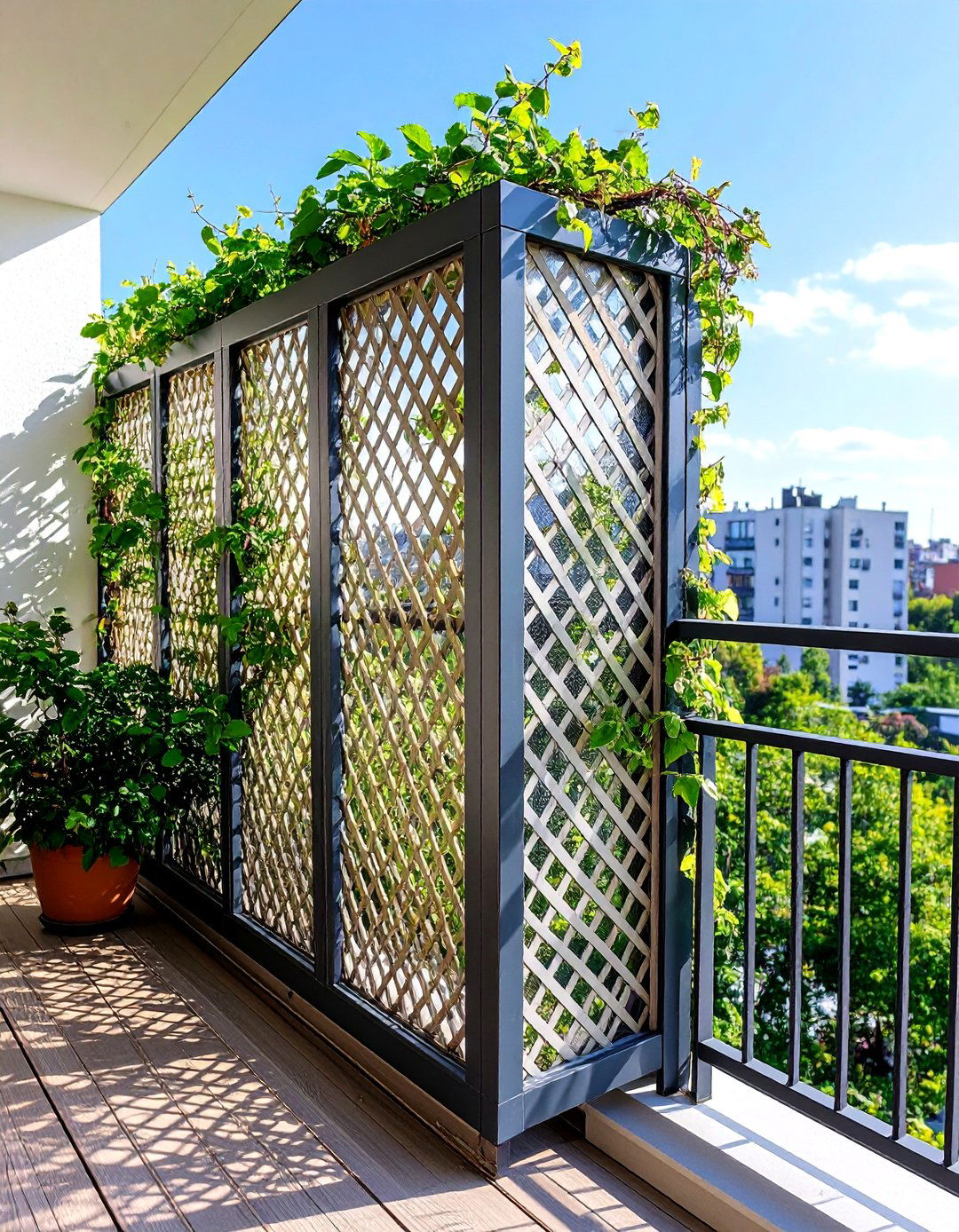
Leave a Reply